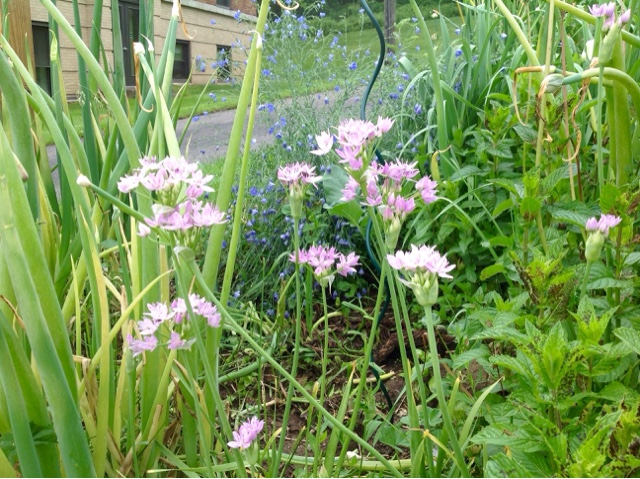Now that's a flower that looks so good you could eat it right up. And as it turns out, you can! In Permaculture, we're always looking for good multi-purpose perennial plants and in that regard you can do no better than the beautiful North American native wild onion, allium unifolium, or "single-leaved onion," which in actuality is neither an onion (it is not in the "onion" species Allium Cepa) nor single-leaved (it usually has 3.) But never mind that, just look at it!
It's a star in the garden, soft-colored, delicate and detailed up close, but at the same time vibrant enough to catch your eye from across the street. And it tastes as good as it looks. As Perennial alliums go, this one is stand-out for flavor, beating both garlic chives, and chives in our tastes tests here at Lillie House. Every part of the plant is edible, with a sweetness that (in my experience) surpasses other vegetables in the allium family, paired with a mild "onion" flavor and a spicy zing that gets your attention then quickly fades. The flowers make a zingy garnish and the leaves can be used like chives, but the best part is the flower stalk, which has the potential for a truly gourmet vegetable.
There it is above. It looks similar to asparagus, but has a delicate crispness similar to a freshly picked pea pod. This is similar to the gourmet use of garlic chive stalks, though the unifolium stalks are much larger, sweeter and, in our opinion, have a nicer flavor.
One potential drawback is that Allium Unifolium is likely to be less productive than other perennial alliums, as it spreads less quickly than weedy plants like chives. But it makes up for this with a willingness to grow in dry soil, an (alleged--we're still testing this) ability to compete with grasses and an ephemeral growth pattern (it dies back in summer and returns the following spring) that could make it very useful as a "catch crop" in polycultures and no-dig gardens. For example, we're testing this flower on the edges of our annual no-dig garden beds, knowing it will help keep weeds at bay in the spring, then politely fade back rather than compete with our tomatoes or squash.
And finally, while it's not strictly native to the Great Lakes region, it gives many of our native insects a food source that would be familar to them on the western part of their range. Sure enough, the bees and native pollinators seem to love Allium Unifolium as much as I do.
Profile:
Single-leaved onion, One leaf onion, American onion, Allium Unifolium
Bulb, grows in a grass-like clump similar to chives. Probably produces larger stalks if thinned somewhat.
Habitat: Mediteranean climate with dry summers, prefers clay soils but will grow in sand. Potential to grow well in garden habitat where top soil levels (where the bulbs grow) dry out in summer, such as where drip or hand irrigation are used--or where no irrigation is used. Will rot if too wet in the summer.
Zones: (5)6-10. Mixed reports, but it has overwintered without loss in our coldest Kalamazoo (zone 6, was zone 5) winter in over 40 years.
Cultivation: Easiy grown from seed, or divided from clumps in the Spring or Fall as with chives or garlic chives. Probably requires cold stratification. Resources:
There are presently few resources on this uncommon allium. If you know of any, please let me know.
Plants for a future: http://www.pfaf.org/user/Plant.aspx?LatinName=Allium+unifolium







No comments:
Post a Comment